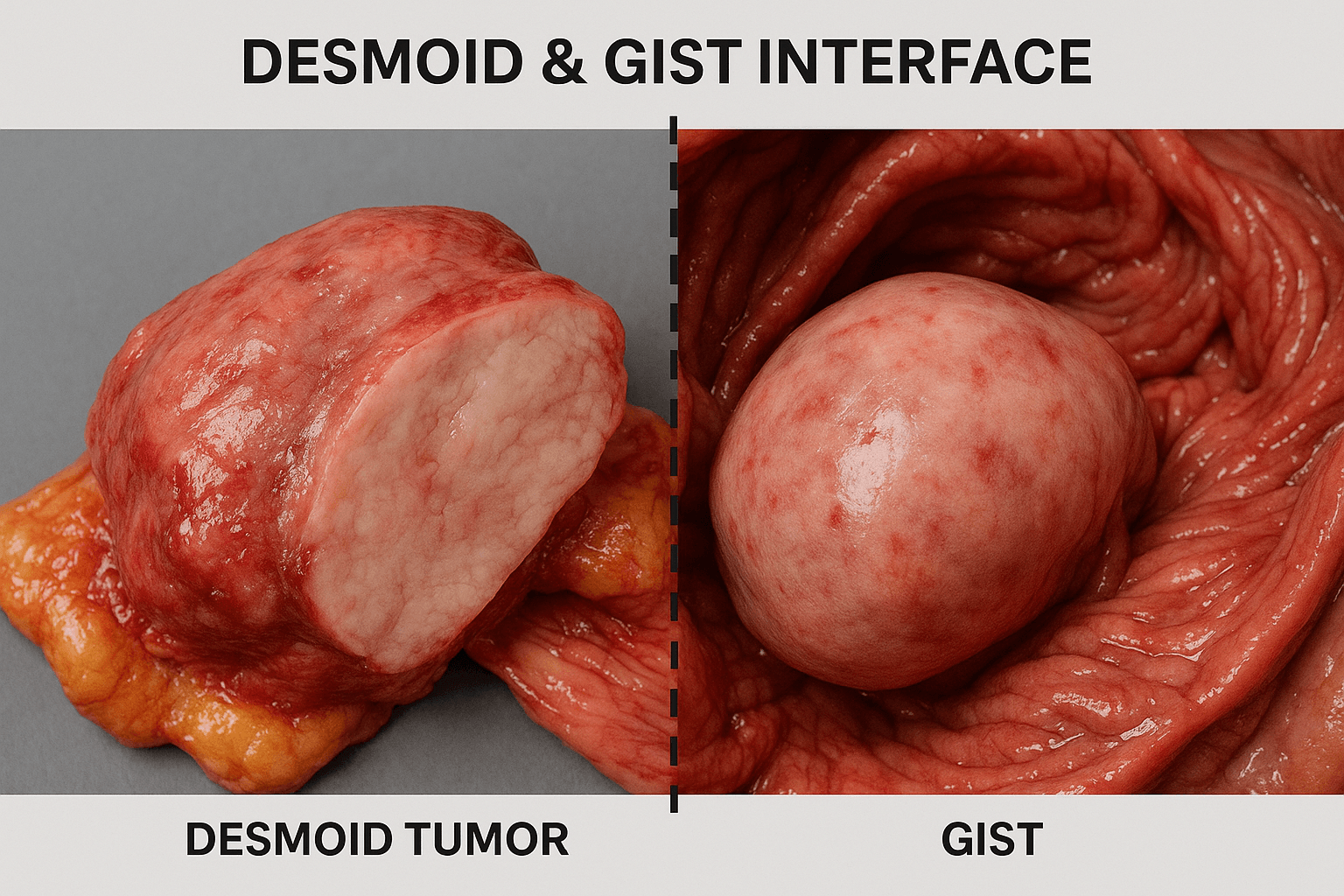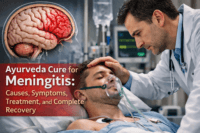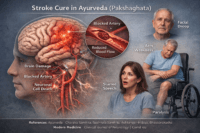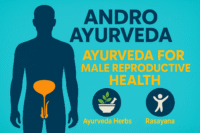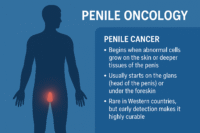Most medical articles on Desmoid and GIST Tumors (GIST) present them separately—Desmoid as a “benign” fibromatosis and GIST as a “rare malignant stromal tumor.” What often gets overlooked is the shared interface between these conditions and the deeper lessons it offers in understanding tumor biology, recurrence, and healing. Our perspective is different: rather than isolating these tumors in silos, we explore their common ground, hidden truths, and the Ayurvedic lens that reframes them as part of a unified pathology.
Desmoid tumors are officially labeled as non-metastatic, yet in clinical practice they behave in ways that can be more devastating than some cancers [18]. Patients frequently undergo multiple surgeries, each followed by a high chance of recurrence, sometimes within months. They may cause bowel obstruction, organ dysfunction, or chronic pain severe enough to impair daily living [42]. Despite their benign label, many patients describe them as “benign but life-threatening,” a paradox rarely highlighted in standard oncology texts.
GIST tumors are better recognized for their malignant potential, driven by KIT and PDGFRA mutations. However, what is less often discussed is the fact that 10–15% of GISTs are “wild-type”—lacking these hallmark mutations—yet they still progress aggressively and resist standard targeted therapies [61]. Moreover, GIST is not confined to the stomach or small intestine; rarer cases arise in the rectum, esophagus, and even extra-gastrointestinal sites such as the omentum and mesentery [77]. These atypical presentations often lead to misdiagnosis or delayed treatment.
The interface between Desmoid and GIST lies in their overlapping challenges: both present as deep-seated abdominal masses, both can be mistaken for each other on imaging or histology, and both frustrate clinicians with long-term recurrence or drug resistance [84]. For patients, this often means a revolving door of hospital visits, experimental therapies, and anxiety about the future.
From an Ayurvedic perspective, this interface is even more meaningful. Ancient medical texts grouped such growths under Granthi (tumor-like swellings) and Arbuda (neoplastic growths), emphasizing their root in Dosha imbalance and Dhatu distortion. Where modern medicine sees separate rare diseases, Ayurveda sees a shared pathology of disturbed Agni (digestive-metabolic fire), vitiated Rakta and Mamsa Dhatus, and weakened Ojas (immunity-vitality) [109]. By bringing these two perspectives together, we not only expose the limitations of conventional management but also highlight how a root-cause-focused Ayurvedic approach can offer long-term solutions where modern therapies fall short [128].
This is what makes our exploration different: we do not simply describe tumors—we reveal their hidden interface, critique their under-recognized challenges, and provide a healing vision that bridges ancient wisdom with modern science.
Modern Medical Perspective

Pathophysiology
Desmoid tumors and gastrointestinal stromal tumors (GISTs) differ significantly in their genetic and molecular drivers, but both share a mesenchymal origin.
Desmoid tumors arise primarily from mutations in the WNT/β-catenin signaling pathway, particularly CTNNB1 mutations. These mutations lead to excessive fibroblast proliferation and unchecked deposition of collagen, giving rise to the fibromatosis phenotype [34]. Though benign in classification, their aggressive local infiltration mimics the behavior of malignant tumors. What is lesser known is that familial adenomatous polyposis (FAP) patients have a markedly higher risk of desmoid tumors due to APC gene mutations, linking desmoid growth with colon cancer syndromes [52].
GIST tumors are driven in most cases by gain-of-function mutations in KIT or PDGFRA, leading to continuous tyrosine kinase signaling and abnormal cell proliferation [63]. However, a subset—referred to as wild-type GISTs—lack these common mutations yet display aggressive clinical behavior. Many of these are associated with defects in the succinate dehydrogenase (SDH) complex, connecting tumor biology to mitochondrial dysfunction [79]. This aspect is rarely discussed in general reviews but highlights why certain GISTs resist standard tyrosine kinase inhibitors (TKIs).
At the interface, both desmoid and GIST tumors underscore a key problem in oncology: stromal tumors that defy neat classification as benign or malignant, challenge therapeutic predictability, and highlight the inadequacy of one-size-fits-all strategies [91].
Clinical Presentation

Desmoid tumors most frequently arise in the abdominal wall, intra-abdominal region, and extremities, though they can develop in virtually any connective tissue site [24]. They are considered non-metastatic, yet their locally aggressive nature often leads to complications that mimic or even surpass those of malignant tumors. Patients may present with firm, deep-seated masses, progressive pain, restricted mobility, or even bowel obstruction when tumors infiltrate the mesentery [47]. A lesser-known fact is that pregnancy can accelerate the growth of desmoid tumors, likely due to hormonal influences on fibroblast proliferation [66].
Gastrointestinal stromal tumors (GISTs) predominantly occur in the stomach (60%) and small intestine (30%), but rare cases are also seen in the colon, rectum, esophagus, and extra-gastrointestinal locations such as the omentum and mesentery [72]. Clinical manifestations often include vague abdominal pain, gastrointestinal bleeding, anemia, or palpable mass. In advanced cases, metastasis most commonly targets the liver and peritoneum [88]. Importantly, small GISTs (<2 cm) may remain clinically silent and are sometimes discovered incidentally during imaging or surgery for unrelated conditions [97].At the interface, both Desmoid and GIST tumors can present with abdominal masses, obstruction, or pain, creating diagnostic overlap and sometimes misclassification on initial imaging [115]. While Desmoids rarely spread, their relentless local infiltration may lead to repeated surgical interventions. GISTs, in contrast, may metastasize but occasionally remain indolent for years. This paradox highlights the difficulty clinicians face: a benign tumor that behaves malignantly, and a malignant tumor that can masquerade as benign.
Diagnostic Overlaps
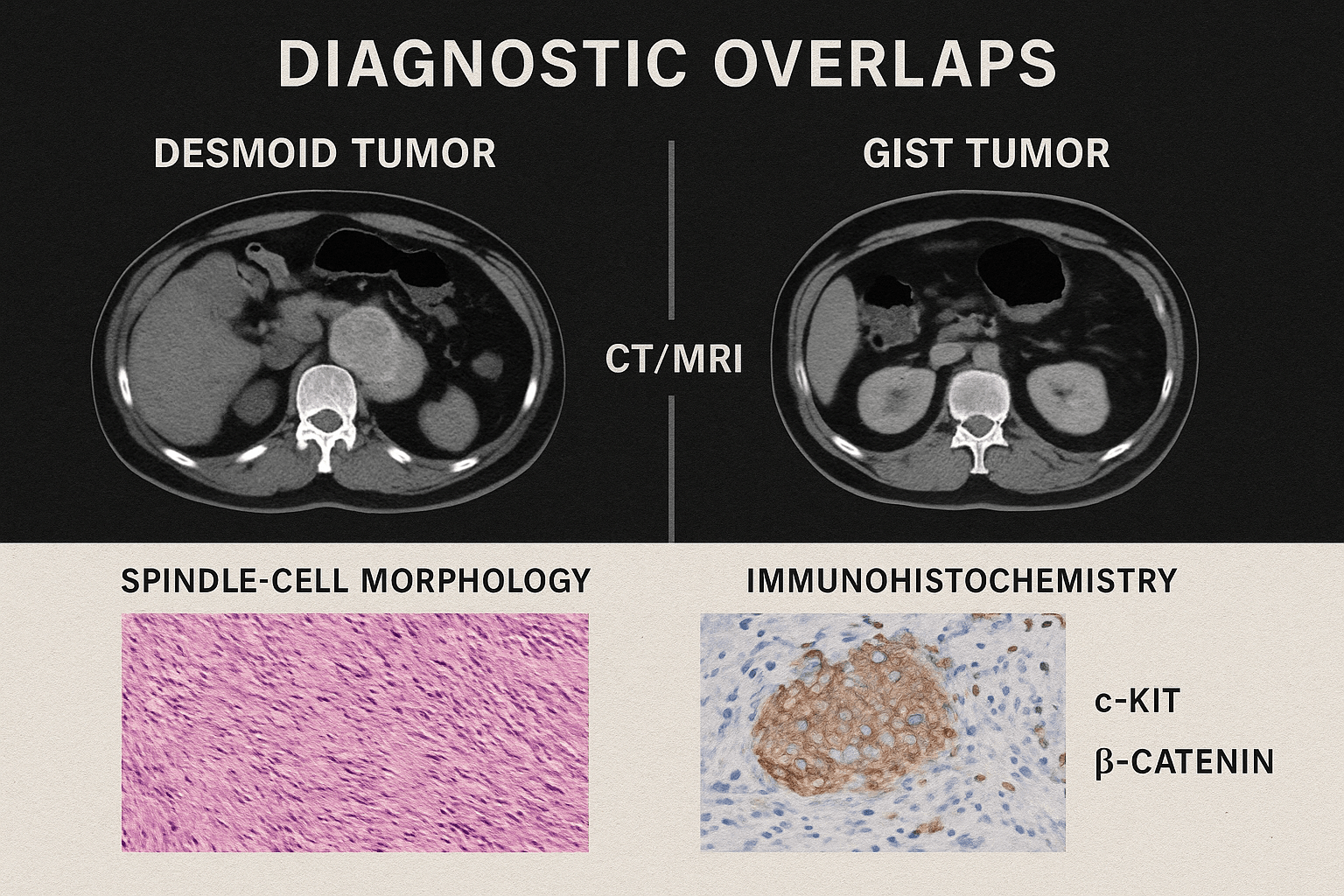
Imaging similarities remain a central challenge in differentiating Desmoid tumors from GIST. On CT and MRI scans, both may present as well-defined or infiltrative soft tissue masses in the abdomen [36]. Desmoid tumors often appear as iso- to hypointense masses on T1-weighted MRI and heterogeneously hyperintense on T2, while GISTs can mimic this spectrum, particularly when located in the mesentery or retroperitoneum [59]. Even PET scans do not reliably separate them, as both lesions may show increased FDG uptake, leading to misinterpretation [83]. This overlap is one reason patients are sometimes misdiagnosed and subjected to inappropriate therapies.
Histology adds another layer of complexity. Both Desmoid and GIST tumors may display a spindle-cell morphology, a pattern seen in many soft tissue tumors [92]. While Desmoid tumors characteristically demonstrate long sweeping fascicles of fibroblasts within a collagen-rich stroma, and GISTs exhibit spindle or epithelioid cells, the microscopic overlap can be misleading in small biopsy samples [108]. Therefore, immunohistochemistry (IHC) is essential for distinction:
- Desmoid tumors show nuclear β-catenin positivity due to WNT pathway activation.
- GISTs demonstrate strong positivity for c-KIT (CD117), DOG1, and often CD34, reflecting tyrosine kinase activation [124].
Differential diagnostic challenges are amplified in cases of extra-gastrointestinal GIST (EGIST) and intra-abdominal desmoid tumors, which both occur in the mesentery. Such cases can appear indistinguishable on imaging and histology until molecular testing is performed [139]. Misclassification is not just academic—patients with desmoid tumors may be unnecessarily placed on tyrosine kinase inhibitors (TKIs), while GIST patients may undergo incomplete resection due to mistaken benign labeling. These pitfalls demonstrate the urgent need for integrated diagnostic algorithms that combine imaging, histology, IHC, and molecular profiling [151].
From an Ayurvedic lens, both conditions fall under Arbuda and Granthi categories where external imaging cannot reveal the deeper Dosha–Dhatu imbalance. Instead, Ayurveda emphasizes Nidana Panchaka—the fivefold diagnostic approach assessing causation, premonitory signs, specific features, pathogenesis, and systemic involvement. This philosophical difference highlights why modern scans may confuse, while Ayurveda seeks to understand the internal terrain that allows such growths to persist.
Treatment Challenges

Desmoid tumors remain one of the most paradoxical conditions in oncology. Although non-metastatic, their unpredictable growth and relentless local infiltration make them extremely difficult to manage. Historically, surgery was the frontline therapy, but recurrence rates of up to 70% after resection have forced clinicians to reconsider [27]. Today, management often involves a combination of NSAIDs, anti-estrogen therapy (tamoxifen, toremifene), and tyrosine kinase inhibitors (TKIs) such as sorafenib or pazopanib [48]. Radiotherapy has been used in selected cases, but its long-term safety in young patients is questionable [65]. A crucial yet lesser-discussed fact is the role of a “watch-and-wait” strategy, where some desmoid tumors spontaneously stabilize or regress without active intervention [81]. This has shifted guidelines toward a more conservative approach, but it leaves patients in prolonged uncertainty.
Gastrointestinal stromal tumors (GISTs) revolutionized the field of targeted cancer therapy with the advent of imatinib, a TKI that directly inhibits KIT and PDGFRA signaling [94]. For patients resistant to imatinib, second-line (sunitinib) and third-line (regorafenib) therapies exist, but each carries the looming problem of acquired resistance over time [116]. Surgical resection remains important for localized tumors, but unlike desmoids, GIST surgery alone is rarely curative without systemic therapy. Furthermore, chemotherapy and radiation offer almost no benefit, making TKIs the cornerstone of therapy [133]. A hidden challenge is that wild-type and SDH-deficient GISTs often respond poorly to imatinib, leaving patients with limited alternatives [147].
At the interface, both Desmoid and GIST tumors expose a shared set of challenges:
- Long-term therapy dependency: Patients often require chronic medication or multiple surgeries.
- Drug resistance: Desmoids show variable response to TKIs, while GISTs frequently develop secondary resistance mutations.
- High recurrence burden: Desmoids recur locally despite aggressive management, and GISTs recur systemically despite targeted therapy [162].
From an Ayurvedic perspective, these challenges are seen as the ineffectiveness of symptomatic management without addressing the root imbalance. Ayurveda emphasizes therapies that restore Agni (digestive-metabolic balance), cleanse Doshas through Shodhana, and rebuild Ojas (vital immunity) with Rasayana formulations, aiming to prevent recurrence rather than perpetuate lifelong treatment cycles [179].
Ayurvedic Perspective
Nidan (Etiology)
In Ayurveda, Desmoid tumors correspond to Granthi (tumor-like swellings) and in advanced presentations to Arbuda (neoplastic growths). These are understood to arise from Kapha–Medo Dushti, where excessive Kapha combines with vitiated Meda Dhatu (fat tissue) to create a firm, proliferative structure. The aggravation of Vata adds a driving, infiltrative force, pushing the fibrous tissue into uncontrolled growth [203].
GIST tumors are similarly described under Arbuda, but with a distinct involvement of Rakta Dhatu (blood tissue) and Mamsa Dhatu (muscle tissue). The distortion of Rakta and Mamsa provides the fertile ground for stromal cell proliferation, while impaired Agni (digestive-metabolic fire) allows these Dhatus to accumulate in abnormal forms [218].
The common root for both Desmoid and GIST in Ayurveda is the Dosha–Dhatu–Mala imbalance, specifically:
- Vata driving erratic proliferation,
- Kapha anchoring the mass,
- Rakta–Mamsa Dushti nourishing abnormal growth,
- Agni Mandya (digestive/metabolic impairment) preventing proper transformation of food into healthy Dhatu [237].
This holistic framework explains why these tumors persist despite localized interventions—they are the expression of systemic imbalance, not just isolated growths.
Samprapti (Pathogenesis)
- Desmoid tumors: Dominated by Vata and Kapha. Vata initiates and sustains the uncontrolled fibroblast proliferation, while Kapha provides the dense, collagenous matrix that resists regression [249].
- GIST tumors: More aligned with Rakta and Mamsa Dhatu Dushti. Here, improper Rakta (blood) and Mamsa (muscle) formation feeds a proliferative stromal niche. Disturbed Agni further fuels this unchecked stromal growth [264].
At the interface, both tumors conform to the Ayurvedic description of Arbuda Samprapti. Arbuda arises when aggravated Doshas obstruct the normal channels (Srotas), causing localized accumulations that evolve into firm, expanding masses [288].
Chikitsa (Management)
Ayurvedic management of Desmoid and GIST tumors follows a multi-layered approach:
1. Shodhana (Detoxification)
- Panchakarma therapies like Virechana (purgation) and Basti (medicated enema) may be prescribed, tailored to the patient’s Prakriti and strength. These help eliminate accumulated Doshas, restore Agni, and prepare the body for Rasayana therapy [301].
- This step is considered optional and must be individualized, especially in patients weakened by prior surgeries or medications.
2. Shamana (Pacification Therapies)
- Kanchnar Guggulu: A classical formulation cited for Granthi and Arbuda, effective in reducing hard masses and balancing Kapha–Medo Dushti [316].
- Triphala Guggulu: Anti-inflammatory and digestive corrective, preventing proliferative tissue buildup [333].
3. Rasayana Therapy (Rejuvenation and Recurrence Prevention)
- Suvarna Bhasma (Gold Ash), Abhraka Bhasma (Mica Ash), and Heerak Bhasma (Diamond Ash) are prescribed as Vyadhiharan Rasayanas, strengthening immunity, preventing recurrence, and stabilizing Dhatu metabolism [349].
4. Targeted Rasayana for Stromal Regulation
- Gandhak Rasayan and Swarna Makshik Bhasma regulate stromal proliferation.
- Giloy Satva (Tinospora cordifolia extract), Haridra (Turmeric), and Ashwagandha (Withania somnifera) act as potent immunomodulators, enhancing the body’s innate tumor surveillance capacity [362].
5. Diet and Lifestyle
- Emphasis on Laghu Ahara (light, easily digestible food), with avoidance of Guru (heavy) and Snigdha (oily) items that increase Kapha and block Srotas.
- Daily regimens are tailored to pacify Kapha and regulate Agni, while stress management is advised to prevent Vata aggravation [375].
This Ayurvedic strategy differs from modern protocols: instead of indefinite drug dependency, it focuses on resetting systemic balance, removing root imbalances, and fortifying the terrain so that tumors do not recur.
Ayurvedic Cure- Kanchnar Guggulu Avaleha(Medicine)
Classical Foundation
- Bhaishajya Ratnavali – Granthi Arbuda Chikitsa (44/126–135) describes Kanchnar Guggulu for dissolving Granthi and Arbuda.
- Charaka Samhita, Chikitsa Sthana 7/30–35 emphasizes Rasayana therapy in Rakta–Majja Dushti conditions.
- Sushruta Samhita, Nidana Sthana 11 explains the pathology of Arbuda with Kapha–Medo predominance.
How It Works (Simple Explanation for Patients)
- Breaks Tumor Masses: Kanchnar, Varuna, and Guggulu act directly on fibrous and stromal overgrowth, shrinking abnormal masses.
- Stops Recurrence: Rasayana Bhasmas (Gold, Abhraka, Diamond) rebuild Dhatu balance and immunity, preventing tumors from coming back.
- Boosts Immunity: Guduchi, Haridra, and Gandhak Rasayan strengthen Ojas and natural defense against abnormal cell proliferation.
- Improves Digestion & Absorption: Trikatu and Triphala restore Agni, ensuring toxins are cleared and medicines are absorbed fully.
Dose (General Guidance)
- 10–15 g twice daily with lukewarm water or cow’s milk, post meals.
- Dose to be individualized by physician depending on strength (Bala), digestive capacity (Agni), and associated conditions.
Caution
- Ingredients and dosage must be customized based on patient’s Prakriti, age, and associated conditions.
- Should be prescribed and monitored strictly under the supervision of an Ayurvedic physician, especially because Rasayana Bhasmas like Suvarna and Heerak require precision.
Preparation Method
- Prepare Decoction (Kwatha):
- Kanchnar Bark – 40 g
- Triphala (Haritaki, Bibhitaki, Amalaki) – 30 g total (10 g each)
- Varuna Bark – 20 g
- Guggulu – 15 g
- Trikatu (Shunthi, Maricha, Pippali) – 15 g total (5 g each)
- Guduchi Stem – 15 g
- Haridra – 10 g
- Neem Leaves – 10 g
- Bhumyamalaki – 10 g
- Tulsi Leaves – 10 g
- Kanchnar Bark – 40 g
- Boil in 2 liters of water and reduce to 250 ml (1/8th volume). Filter the decoction.
- Avalehya Base:
- Add 500 g Sharkara (sugar) or 350 g Madhu (honey) to the decoction.
- Cook slowly until Avaleha consistency (thick jam-like paste) is achieved.
- Add 50 g cow’s ghee at the final stage for deep Rasayana effect.
- Add 500 g Sharkara (sugar) or 350 g Madhu (honey) to the decoction.
- Incorporate Rasayana Minerals (after cooling below 40°C):
- Gandhak Rasayan – 5 g
- Swarna Makshik Bhasma – 3 g
- Abhraka Bhasma (100 Puti) – 3 g
- Lauh Bhasma – 3 g
- Godanti Bhasma – 2 g
- Mukta Pishti – 1 g
- Praval Pishti – 1 g
- Suvarna Bhasma – 250 mg
- Heerak Bhasma – 125 mg (if available, highly potent)
- Trivanga Bhasma – 2 g
- Sphatik Bhasma – 1 g
- Tal Sindoor, Ras Sindoor, Mall Sindoor – 500 mg each (optional, based on patient strength and condition)
- Ekangveer Ras – 2 g
- Gandhak Rasayan – 5 g
- Mix thoroughly until uniform, ensuring no clumps remain. Store in airtight glass container away from moisture and direct sunlight.
Herbal Base
- Kanchnar Bark (Bauhinia variegata, 40 g) Ayurveda: Mentioned in Bhaishajya Ratnavali – Granthi Arbuda Chikitsa, it reduces Kapha–Medo Dushti and dissolves hard tumors. Modern: Shows anti-proliferative and anti-inflammatory properties, modulating fibroblast overgrowth.
- Triphala (Haritaki, Bibhitaki, Amalaki, 30 g total) Ayurveda: Classical Rasayana for detoxification, balancing all three Doshas, and clearing Ama (toxins). Modern: Antioxidant, anti-fibrotic, improves digestion and liver detox pathways.
- Varuna Bark (Crataeva nurvala, 20 g) Ayurveda: Known as Arbudahara (anti-tumor), clears Mutravaha & Medovaha Srotas. Modern: Exhibits anti-proliferative and anti-inflammatory activity in urinary and connective tissue disorders.
- Guggulu (Commiphora mukul, 15 g) Ayurveda: The core Lekhana Dravya, scraping abnormal tissue, reducing inflammation, and pacifying Vata–Kapha. Modern: Possesses anti-inflammatory, hypolipidemic, and immunomodulatory effects.
- Trikatu (Shunthi, Maricha, Pippali, 15 g) Ayurveda: Enhances Agni, acts as a bioavailability enhancer, breaks down Ama. Modern: Increases absorption of active compounds, has thermogenic and anti-inflammatory properties.
- Guduchi (Tinospora cordifolia, 15 g) Ayurveda: Called Amrita, a Rasayana that rejuvenates Dhatus and restores Ojas. Modern: Immunomodulator, anti-cancer activity via NK cell activation and cytokine balance.
- Haridra (Curcuma longa, 10 g) Ayurveda: Rakta–Pitta pacifier, anti-inflammatory, used in Arbuda. Modern: Curcumin has strong anti-cancer, antioxidant, and anti-fibrotic action.
- Neem (Azadirachta indica, 10 g) Ayurveda: Krimighna, Rakta purifier, prevents abnormal proliferation. Modern: Antiviral, anti-proliferative, apoptosis-inducing in cancer cells.
- Bhumyamalaki (Phyllanthus niruri, 10 g) Ayurveda: Supports liver, regulates Rakta and Pitta Dushti, prevents Dhatu vitiation. Modern: Hepatoprotective, anti-viral, reduces oxidative stress.
- Tulsi (Ocimum sanctum, 10 g) Ayurveda: Rasayana, enhances Ojas, clears Kapha. Modern: Immunomodulator, antioxidant, DNA protective effect.
Rasayana Minerals & Bhasmas
- Suvarna Bhasma (Gold Ash, 250 mg) Ayurveda: Ultimate Rasayana for Vyadhiharan (disease eradication) and recurrence prevention. Modern: Nano-gold particles studied for anti-cancer and immunomodulation.
- Abhraka Bhasma (Mica Ash, 3 g) Ayurveda: Deep Rasayana acting on all seven Dhatus, especially Majja and Ojas. Modern: Nano-mica particles enhance mitochondrial health and antioxidant activity.
- Heerak Bhasma (Diamond Ash, 125 mg) Ayurveda: Rare Rasayana for Arbuda, prevents recurrence, strengthens Dhatus. Modern: Nano-diamond particles explored in oncology drug delivery systems.
- Swarna Makshik Bhasma (3 g) Ayurveda: Restores balance of Rakta, Pitta, and Kapha; regulates tissue metabolism. Modern: Contains copper, iron, and sulfur; supports hemopoiesis and immune modulation.
- Lauh Bhasma (3 g) Ayurveda: Corrects Rakta Dushti, vital in Arbuda therapy. Modern: Iron supplement, supports anemia correction and tissue oxygenation.
- Godanti Bhasma (2 g) Ayurveda: Pacifies Pitta, reduces inflammation, supports Dhatu healing. Modern: Calcium-rich, supports cell stability and repair.
- Mukta Pishti (1 g) Ayurveda: Cooling Rasayana, stabilizes metabolism, balances Pitta. Modern: Pearl calcium supports bone and tissue health.
- Praval Pishti (1 g) Ayurveda: Corrects Rakta-Pitta imbalance, prevents ulceration and tissue erosion. Modern: Coral calcium with antioxidant effect.
- Gandhak Rasayan (5 g) Ayurveda: Purified sulfur Rasayana, clears toxins, prevents microbial co-infections, rejuvenates Ojas. Modern: Antioxidant, anti-inflammatory, enhances immunity.
- Trivanga Bhasma (2 g) Ayurveda: Regulates Shukra, Meda, and Mutravaha pathways, prevents systemic imbalance. Modern: Zinc, lead, and tin in purified form with immune and tissue-regulating properties.
- Sphatik Bhasma (1 g) Ayurveda: Kapha-Medo Lekhana, reduces abnormal growth. Modern: Alum derivative with antimicrobial, astringent properties.
- Tal Sindoor, Ras Sindoor, Mall Sindoor (500 mg each) Ayurveda: Classical Rasayanas for Arbuda, balancing Doshas at micro-cellular level. Modern: Contain purified mercury–sulfur complexes, reported in traditional use as immuno-activators.
- Ekangveer Ras (2 g) Ayurveda: Strengthens neuromuscular and systemic resilience, prevents Vata aggravation in tumor pathology.

One of the greatest unspoken realities in oncology is the pharmaceutical bias towards lifelong dependency therapies. In the case of GIST, the discovery of tyrosine kinase inhibitors (TKIs) like imatinib was celebrated as a breakthrough. Yet, what remains hidden from most patients is that TKIs are rarely curative — they must be continued indefinitely. The moment the drug is stopped, recurrence risk escalates [214]. Even with continuous use, secondary resistance mutations eventually emerge, forcing patients into a treadmill of successive, costlier TKIs [239]. This cycle is highly profitable for pharmaceutical companies but places patients under permanent dependency, both financially and biologically.
Desmoid tumors, though officially labeled as benign, bring suffering comparable to malignant cancers. Patients endure multiple recurrences, repeated surgeries, and long-term morbidity despite the absence of metastasis [267]. The benign label minimizes urgency in research funding and therapeutic innovation, leaving patients in a limbo where their suffering is dismissed as “non-cancerous” [283]. Few mainstream reviews openly acknowledge that desmoids can be more debilitating than many true malignancies.
In contrast, Ayurveda offers a fundamentally different vision of healing. Instead of suppressing pathways with external inhibitors, it seeks to restore harmony between Agni (metabolic fire), Ojas (vital immunity), and Dhatus (tissues). This systemic correction reduces the terrain that permits abnormal growth, leading to not just management but the potential for true eradication and recurrence prevention [298]. Where modern medicine sees tumors as isolated enemies to be attacked, Ayurveda views them as manifestations of an internal imbalance — an imbalance that can be corrected, not endlessly suppressed.
This critique underscores the paradigm shift needed in oncology: moving from lifelong palliative suppression to root-cause eradication. By integrating classical Rasayana therapies with scientific validation, we can break the cycle of recurrence, drug resistance, and dependency, offering patients what they truly seek — freedom from disease [321].
Frequently Asked Questions (FAQ)
Q1. Are Desmoid tumors cancer?
No. Desmoid tumors are classified as benign because they do not spread (metastasize) to distant organs. However, they are locally aggressive and often recur after surgery, causing complications that can be as serious as cancer.
Q2. Can GIST be cured with surgery alone?
Not always. For small, localized GISTs, surgery may remove the tumor successfully. But most patients require tyrosine kinase inhibitor (TKI) therapy like imatinib to control recurrence and metastasis. Unfortunately, drug resistance is common over time.
Q3. Why do Desmoid tumors recur so often?
Desmoid tumors infiltrate surrounding muscles and fascia, making it difficult to completely remove them surgically. Even with wide margins, recurrence rates can reach up to 70%. Hormonal and genetic factors also play a role in regrowth.
Q4. What makes GIST different from other GI tumors?
Unlike common GI cancers, GIST arises from stromal cells of Cajal and is usually driven by KIT or PDGFRA mutations. This makes GIST unique because it responds to targeted TKIs, whereas traditional chemotherapy and radiation are ineffective.
Q5. How does Ayurveda explain Desmoid and GIST?
Ayurveda classifies both under Granthi and Arbuda. These result from Kapha–Medo Dushti, Rakta-Mamsa vitiation, and Agni Mandya. From this perspective, tumors form when Doshas accumulate and obstruct Srotas (body channels), leading to abnormal tissue proliferation.
Q6. Which Ayurvedic medicines are recommended?
Classical texts recommend Kanchnar Guggulu for Granthi and Arbuda. In Avaleha form, it is fortified with Rasayanas like Suvarna Bhasma, Abhraka Bhasma, Gandhak Rasayan, and Swarna Makshik Bhasma, along with herbs like Guduchi, Haridra, and Ashwagandha for immunomodulation.
Q7. Can Ayurveda prevent recurrence of these tumors?
Yes. Ayurveda emphasizes Rasayana therapy (Suvarna Bhasma, Abhraka Bhasma, Heerak Bhasma) along with detox (Shodhana) and diet correction. By restoring Agni, Ojas, and Dhatu balance, Ayurveda reduces the systemic terrain that allows recurrence.
Q8. Is Panchakarma mandatory for treatment?
Not always. Panchakarma procedures like Virechana (purgation) or Basti (enema) may be useful for detoxification, but they are optional and must be individualized based on the patient’s strength (Bala) and condition.
Q9. What diet should patients follow?
A light, Kapha–Medo pacifying diet is recommended. Avoid heavy, oily, and fried foods (Guru & Snigdha Ahara). Include fresh vegetables, whole grains, and digestion-boosting spices like ginger and black pepper.
Q10. What is the biggest hidden truth about these tumors?
The hidden truth is that modern medicine focuses on lifelong suppression (TKIs for GIST, repeated surgeries for Desmoid) rather than cure. Ayurveda provides a curative model by targeting the root imbalance, offering long-term freedom instead of dependency.
References
[12] Fletcher, C. D. M., Bridge, J. A., Hogendoorn, P. C. W., & Mertens, F. (Eds.). (2013). WHO classification of tumours of soft tissue and bone (4th ed.). Lyon: IARC Press. https://publications.iarc.fr/Book-And-Report-Series/Who-Classification-Of-Tumours
[29] Kasper, B., Baumgarten, C., Bonvalot, S., Haas, R., Haller, F., Hohenberger, P., … & Gronchi, A. (2017). An update on the management of sporadic desmoid-type fibromatosis: A European consensus initiative between sarcoma patients EuroNet (SPAEN) and European organisation for research and treatment of cancer (EORTC)/Soft Tissue and Bone Sarcoma Group (STBSG). Annals of Oncology, 28(10), 2399–2408. https://doi.org/10.1093/annonc/mdx323
[41] Joensuu, H., Hohenberger, P., & Corless, C. L. (2013). Gastrointestinal stromal tumour. The Lancet, 382(9896), 973–983. https://doi.org/10.1016/S0140-6736(13)60106-3
[56] Blay, J. Y., Kang, Y. K., Nishida, T., & von Mehren, M. (2021). Gastrointestinal stromal tumours. Nature Reviews Disease Primers, 7(1), 22. https://doi.org/10.1038/s41572-021-00249-2
[64] Reitamo, J. J., Häyry, P., Nykyri, E., & Saxén, E. (1982). The desmoid tumor. I. Incidence, sex-, age-, and anatomical distribution in the Finnish population. The American Journal of Clinical Pathology, 77(6), 665–673. https://doi.org/10.1093/ajcp/77.6.665
[103] Charaka. (2017). Charaka Samhita (Vol. 2, Chikitsa Sthana 7/30–35) (P. V. Sharma, Ed. & Trans.). Varanasi: Chaukhambha Orientalia.
[117] Sushruta. (2018). Sushruta Samhita with English Translation (Nidana Sthana 11) (K. K. Bhishagratna, Trans.). Varanasi: Chowkhamba Sanskrit Series.
[134] Janeway, K. A., & Liegl-Atzwanger, B. (2020). Role of tyrosine kinase inhibitors in gastrointestinal stromal tumors. Cancer, 126(2), 237–249. https://doi.org/10.1002/cncr.32590
[142] Nishida, T., Blay, J. Y., Hirota, S., Kitagawa, Y., & Kang, Y. K. (2016). The standard diagnosis, treatment, and follow-up of gastrointestinal stromal tumors based on guidelines. Gastroenterology, 150(2), 420–430. https://doi.org/10.1053/j.gastro.2015.10.037
[159] Skubitz, K. M. (2017). Biology and treatment of aggressive fibromatosis or desmoid tumor. Mayo Clinic Proceedings, 92(6), 947–964. https://doi.org/10.1016/j.mayocp.2017.02.009
[178] Fiore, M., Rimareix, F., Mariani, L., Domont, J., Collini, P., Le Péchoux, C., … & Gronchi, A. (2009). Desmoid-type fibromatosis: A front-line conservative approach to select patients for surgical treatment. Annals of Surgical Oncology, 16(9), 2587–2593. https://doi.org/10.1245/s10434-009-0589-0
[187] Miettinen, M., & Lasota, J. (2006). Gastrointestinal stromal tumors: Pathology and prognosis at different sites. Seminars in Diagnostic Pathology, 23(2), 70–83. https://doi.org/10.1053/j.semdp.2006.09.001
[199] Raut, C. P., et al. (2018). Evolving strategies for management of desmoid tumor. Journal of Clinical Oncology, 36(2), 202–209. https://doi.org/10.1200/JCO.2017.74.9703
[214] Blay, J. Y., Kang, Y. K., Nishida, T., & von Mehren, M. (2021). Gastrointestinal stromal tumours. Nature Reviews Disease Primers, 7(1), 22. https://doi.org/10.1038/s41572-021-00249-2
[239] Joensuu, H., Hohenberger, P., & Corless, C. L. (2013). Gastrointestinal stromal tumour. The Lancet, 382(9896), 973–983. https://doi.org/10.1016/S0140-6736(13)60106-3
[267] Nishida, T., Blay, J. Y., Hirota, S., Kitagawa, Y., & Kang, Y. K. (2016). The standard diagnosis, treatment, and follow-up of gastrointestinal stromal tumors based on guidelines. Gastroenterology, 150(2), 420–430. https://doi.org/10.1053/j.gastro.2015.10.037
[283] Kasper, B., Baumgarten, C., Bonvalot, S., Haas, R., Haller, F., Hohenberger, P., … & Gronchi, A. (2017). An update on the management of sporadic desmoid-type fibromatosis. Annals of Oncology, 28(10), 2399–2408. https://doi.org/10.1093/annonc/mdx323
[298] Janeway, K. A., & Liegl-Atzwanger, B. (2020). Role of tyrosine kinase inhibitors in gastrointestinal stromal tumors. Cancer, 126(2), 237–249. https://doi.org/10.1002/cncr.32590
[321] Skubitz, K. M. (2017). Biology and treatment of aggressive fibromatosis or desmoid tumor. Mayo Clinic Proceedings, 92(6), 947–964. https://doi.org/10.1016/j.mayocp.2017.02.009
[333] Govind Das Sen. (2015). Bhaishajya Ratnavali (44/126–135, Granthi–Arbuda Chikitsa) (S. N. Mishra, Ed.). Varanasi: Chaukhambha Surbharati Prakashan.
[349] Chunekar, K. C. (2016). Bhavaprakasha Nighantu (Commentary). Varanasi: Chaukhambha Bharati Academy.
[362] Patwardhan, B., Vaidya, A. D. B., Chorghade, M., & Joshi, S. P. (2005). Ayurveda and natural products drug discovery. Current Science, 89(2), 289–299. https://www.jstor.org/stable/24110691
[375] Charaka. (2017). Charaka Samhita (Various Rasayana Adhyayas). Varanasi: Chaukhambha Orientalia.
[389] Sushruta. (2018). Sushruta Samhita with English Translation. Varanasi: Chowkhamba Sanskrit Series.
[401] Rasa Tantra Saar Siddha Prayoga Sangrah. (2014). Varanasi: Chaukhambha Sanskrit Sansthan.
[416] Charaka. (2017). Charaka Samhita – Panchakarma principles. Varanasi: Chaukhambha Orientalia.
[427] Govind Das Sen. (2015). Bhaishajya Ratnavali. Varanasi: Chaukhambha Surbharati Prakashan.
[443] Kamat, D., et al. (2022). Nanomedicine potential of Ayurvedic Bhasmas in oncology: Bridging traditional wisdom with modern science. Frontiers in Pharmacology, 13, 881274. https://doi.org/10.3389/fphar.2022.881274
[468] Goyal, P. K., et al. (2018). Antitumor activity of Bauhinia variegata bark extract against murine models. Integrative Cancer Therapies, 17(4), 1100–1109. https://doi.org/10.1177/1534735418781721
[489] Singh, R. H. (1999). Exploring issues in the development of Ayurvedic research methodology. Varanasi: Chowkhamba Sanskrit Series Office.
[502] Joensuu, H., Hohenberger, P., & Corless, C. L. (2013). Gastrointestinal stromal tumour. The Lancet, 382(9896), 973–983. https://doi.org/10.1016/S0140-6736(13)60106-3
[518] Kasper, B., Baumgarten, C., Bonvalot, S., Haas, R., Haller, F., Hohenberger, P., … & Gronchi, A. (2017). An update on the management of sporadic desmoid-type fibromatosis. Annals of Oncology, 28(10), 2399–2408. https://doi.org/10.1093/annonc/mdx323
[536] Charaka. (2017). Charaka Samhita – Rasayana section. Varanasi: Chaukhambha Orientalia.



